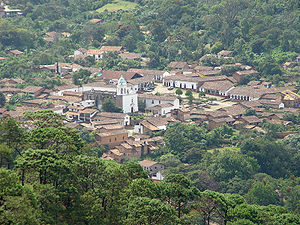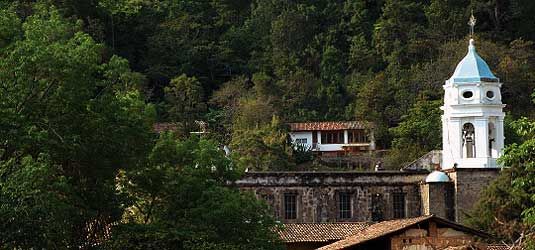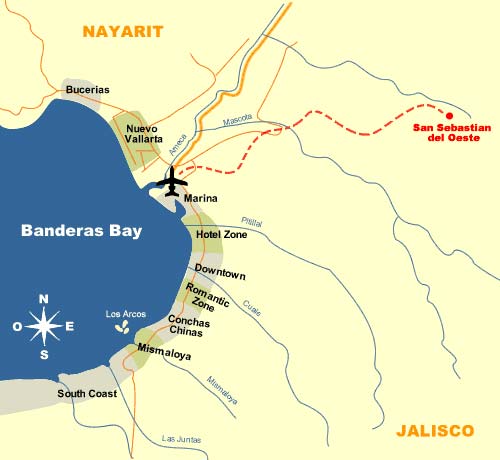Back to list news



|
San Sebastian Del Oeste (West)
July 09, 2010
San Sebastian del Oeste is named so to differentiate it from Spain's own San Sebastian at the north-east coast of the Basque province. It is now an
UNESCO World Heritage site. When its mines were discovered by the Spanish colonists in 1605, the town was founded. One of its most beautiful attributes is
the close harmony with its natural surroundings that has been maintained to this day, and covers nearly 2000 square miles. The town itself spreads over
37 partially settled hectares, on which, amazingly, still stand enormous haciendas and mansions, very well maintained, left over from the colonial period.
Having been one of the main mining centres of New Spain, 30 mines were established there and around these grew ten gold and silver reduction haciendas.
San Sebastian officially became a city in 1830, and its population exceeded 20,000 (compared to today's approximate 600). Some 80 years later, the Mexican
Revolution overtook it and rid it of foreign investors, who moved to other mines around Mexico. After this, San Sebastian virtually disappeared from the
world map. Today, its main economic activities include agriculture, stockbreeding, increasing tourism and, to some extent, forestry.
The town is halved by a river, on whose banks several foundries were built, in the 18th and 19th centuries. Because of the use of traditional
Spanish building methods and structures, San Sebastian has the appearance of having been conserved intact since its establishment nearly four centuries ago.
Now its irregular layout consists of original plazas and public squares, winding alleyways with their original cobblestones, arches, plastered mud-brick walls,
attics, wooden and tiled roofs.
While most of San Sebastian exists at some 1500m above sea level, its southernmost part is a good deal higher, ranging at 1800m above sea level. From here
it is possible to see a panoramic view of the hills that slope downwards and away, where many buildings from the 17th, 18th and 19th centuries continue to
exist in surprisingly good condition. The natural surroundings that make up the whole of the town are in almost pristine condition; these include such flora
as pine, cedar, oak, monkey-ear tree, or eardrop tree (parota in Spanish). Its fauna consists largely of deer, rabbit, coyote, wild pig, pheasant, squirrel,
falcon and parrot. Among the sports practiced in San Sebastian, outdoors and within its sports centre, are soccer, basketball and volleyball; it has a movie
theatre, museum, a small palisade for public concerts, rodeos and other events, parks, gorgeous gardens and a public library. There are free-for-Mexicans
medical treatment centres as well as public doctors available in San Sebastian.
Beyond the north end of the plaza lies the local church, dedicated by the loving Catholic locals to Saint Sebastian, martyred in Rome in A.D. 288.
It is a replacement of the original church, which was destroyed by an earthquake more than a century ago.
Some widely-recommended restaurants here include Cristy's, around the corner from the basketball court, which serves traditional Mexican food served
fresh and hot. This restaurant is the only one to boast a billiards table. Meals range in price (as in the rest of the Mexican restaurants in town) from
$10 to $20 U.S.
Around the corner from the central telephone office is Coco's, which features home-made pastas and other Italian fare in an outdoor garden.
Across from the north-west corner of the plaza is El Fortin, with a small and cozy outdoor patio. This restaurant features individual-sized pizzas and
other delicious fare that changes daily in the high season, and has a small gallery of local art indoors and a very interesting store between the patio and
interior of the restaurant where you can buy anything from postcards to locally-made candies, wax candles, and incense, and best of all, Raicilla, which is
locally made. You can also find locally grown and harvested organic coffee here. The prices of a meal at the above restaurants can range from $20 to $50 U.S.
Besides these eateries, residents of San Sebastian open their homes for breakfast in the morning, and in the evening for tacos and other traditional
Mexican meals. Luxury Beach Concierge recommends these for those travelling on a budget.
There are many excellent choices for overnight accommodation, which Luxury Beach Concierge highly recommends, after a three hour trip by car or bus on
the highway through Tepic and up the mountainside beyond.
Hacienda Jalisco, which dates from 1840 and was originally the headquarters of the mining company, is now a guest-house featuring high-ceilinged rooms
with fireplaces and private baths. Downstairs is a kitchen and a small museum, accompanied by a vibrant, flowery courtyard and a porticoed veranda. To get
there, you can easily walk about 2 miles downhill until you see a gate which serves as the entrance to this beautifully adorned guest house.
Hotel Posada del Sol is a former hacienda with a central courtyard surrounded by spacious bedrooms, each with their private bath that is probably the
second-least expensive place to spend the night. An exciting thing to do at night is to go through the arched tunnel at the back of the hotel, where there
are a number of unused rooms, lying silent in the darkness, that will give anyone but the most skeptical person a haunted feeling.
The hotel rates range around $100 pesos per night per person. The climate is usually cool because of San Sebastian’s privileged situation in the
Sierra Madres. During winter the temperature can drop to 11 degrees Celsius, so Luxury Beach Concierge recommends at least thick sweaters and socks, if
not Northern winter attire.
If you are so inclined, take a walk away from the central plaza, cross the bridge beyond El Fortin and explore the romantic woods on the other side. Here
you will come across and enclave of wooden cabins, also available for rent, individually or in a group.
|
|
San Sebastian del Oeste is named so to differentiate it from Spain's own San Sebastian at the north-east coast of the Basque province. It is now an
UNESCO World Heritage site. When its mines were discovered by the Spanish colonists in 1605, the town was founded. One of its most beautiful attributes is
the close harmony with its natural surroundings that has been maintained to this day, and covers nearly 2000 square miles. The town itself spreads over
37 partially settled hectares, on which, amazingly, still stand enormous haciendas and mansions, very well maintained, left over from the colonial period. |
|
To get to San Sebastian, you can take the bus that goes to Talpa, which leaves from Calle Havre, a block behind Avenida Francisco Medina Ascencio, where the
Libramiento (Freeway) ends and the Hotel Zone begins. It leaves every two hours, seven days a week. Either that or you can rent a car and drive along the
perfectly safe and well-maintained highway and enjoy the spectacular vistas along the way. Another option is to fly there, on a small plane called Aerotaxi
de la Bahia, which is located at the General Aviation Building at the airport. |
|
|

